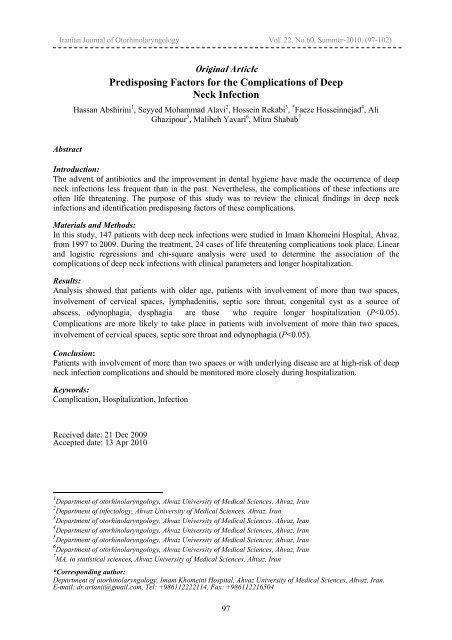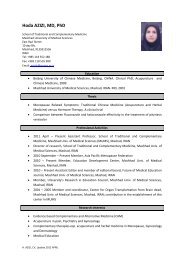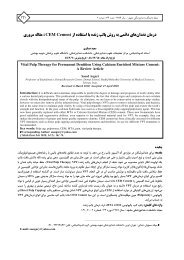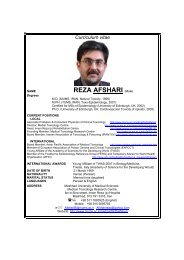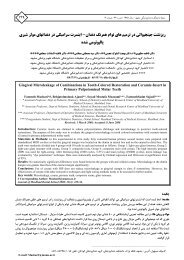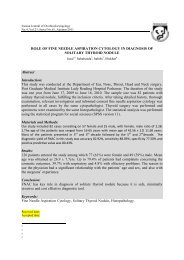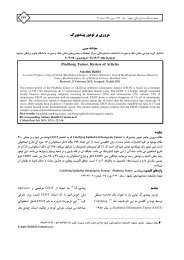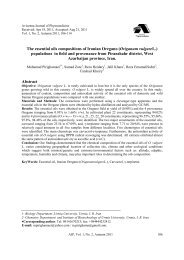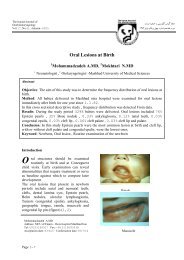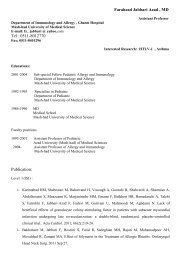Predisposing Factors for the Complications of Deep Neck Infection
Predisposing Factors for the Complications of Deep Neck Infection
Predisposing Factors for the Complications of Deep Neck Infection
You also want an ePaper? Increase the reach of your titles
YUMPU automatically turns print PDFs into web optimized ePapers that Google loves.
Iranian Journal <strong>of</strong> Otorhinolaryngology Vol. 22, No.60, Summer-2010, (97-102)<br />
Abstract<br />
Original Article<br />
<strong>Predisposing</strong> <strong>Factors</strong> <strong>for</strong> <strong>the</strong> <strong>Complications</strong> <strong>of</strong> <strong>Deep</strong><br />
<strong>Neck</strong> <strong>Infection</strong><br />
Hassan Abshirini 1 , Seyyed Mohammad Alavi 2 , Hossein Rekabi 3 , * Faeze Hosseinnejad 4 , Ali<br />
Ghazipour 5 , Maliheh Yavari 6 , Mitra Shabab 7<br />
Introduction:<br />
The advent <strong>of</strong> antibiotics and <strong>the</strong> improvement in dental hygiene have made <strong>the</strong> occurrence <strong>of</strong> deep<br />
neck infections less frequent than in <strong>the</strong> past. Never<strong>the</strong>less, <strong>the</strong> complications <strong>of</strong> <strong>the</strong>se infections are<br />
<strong>of</strong>ten life threatening. The purpose <strong>of</strong> this study was to review <strong>the</strong> clinical findings in deep neck<br />
infections and identification predisposing factors <strong>of</strong> <strong>the</strong>se complications.<br />
Materials and Methods:<br />
In this study, 147 patients with deep neck infections were studied in Imam Khomeini Hospital, Ahvaz,<br />
from 1997 to 2009. During <strong>the</strong> treatment, 24 cases <strong>of</strong> life threatening complications took place. Linear<br />
and logistic regressions and chi-square analysis were used to determine <strong>the</strong> association <strong>of</strong> <strong>the</strong><br />
complications <strong>of</strong> deep neck infections with clinical parameters and longer hospitalization.<br />
Results:<br />
Analysis showed that patients with older age, patients with involvement <strong>of</strong> more than two spaces,<br />
involvement <strong>of</strong> cervical spaces, lymphadenitis, septic sore throat, congenital cyst as a source <strong>of</strong><br />
abscess, odynophagia, dysphagia are those who require longer hospitalization (P
<strong>Complications</strong> <strong>of</strong> <strong>Deep</strong> <strong>Neck</strong> <strong>Infection</strong> Abshirini H, et al<br />
Introduction<br />
<strong>Deep</strong> neck infections can originate from<br />
different parts <strong>of</strong> <strong>the</strong> neck like teeth, salivary<br />
glands, paranasal sinuses, pharynx and<br />
adenotonsil tissue. The life-threatening<br />
infections which are originated from teeth or<br />
upper aerodigestive tract may intrude into<br />
potential spaces that are covered by neck<br />
fasciitis. Infective involvement <strong>of</strong> <strong>the</strong>se<br />
spaces has substantially declined by<br />
antibiotics consumption (1,2).<br />
Never<strong>the</strong>less, <strong>the</strong> risk <strong>of</strong> <strong>the</strong> mortality and<br />
morbidity is not unlikely especially when <strong>the</strong><br />
complications exist. In a study <strong>of</strong> 196 cases<br />
presenting deep neck infections, 15 patients<br />
had been afflicted by deadly complications (2).<br />
These include mediastinitis, empyema,<br />
pericardical effusion and jugular vein<br />
thrombosis. <strong>Neck</strong> necrotizing fasciitis can<br />
cause dyspnea, delerium, mediastinitis,<br />
pericardial tamponade, DIC, and neuropathy<br />
which is responsible <strong>for</strong> 64% <strong>of</strong> mortality<br />
cases that is 15% higher than isolated neck<br />
involvement. Today, <strong>the</strong> main source <strong>of</strong> neck<br />
infections in children and adults are tonsil<br />
and dental infections, respectively (3). In this<br />
research we studied influential factors in<br />
developing and progressing neck abscesses<br />
and <strong>the</strong>ir relationship with complications and<br />
length <strong>of</strong> hospitalization time.<br />
Materials and Methods<br />
In our study which has been done<br />
retrospectively, 147 cases <strong>of</strong> deep neck<br />
infections that were under treatment in <strong>the</strong><br />
Imam Khomeini Hospital <strong>of</strong> Ahvaz from<br />
1997 to 2009 were studied and abscess<br />
cultures were per<strong>for</strong>med <strong>for</strong> all <strong>of</strong> <strong>the</strong>m.<br />
Twenty four <strong>of</strong> <strong>the</strong>m were afflicted by lifethreatening<br />
complications during treatment.<br />
By two methods <strong>of</strong> linear regression and<br />
logistic regression, clinical parameters<br />
including longer hospitalization and<br />
occurrence <strong>of</strong> complications were studied.<br />
The cases with dermal infections, infections<br />
associated with external neck wounds or<br />
head and neck tumors were excluded.<br />
Diagnostic criterion <strong>for</strong> all patients was 10cc<br />
syringe aspiration after being visited by<br />
otolaryngologists or assistants except<br />
98<br />
suspects <strong>of</strong> retrophyrangial abscesses and<br />
deeper spaces involvement which were<br />
recognized by contrast-enhanced CT. As a<br />
primary treatment, surgery (incision and<br />
drainage) was per<strong>for</strong>med <strong>for</strong> all cases and<br />
intravenous antibiotics (penicillin,<br />
metronidazole ± ceftriaxone) were prescribed<br />
until receiving <strong>the</strong> result <strong>of</strong> <strong>the</strong> cultures.<br />
Based on Lee and his colleagues, variables<br />
were selected <strong>for</strong> study which include<br />
dependent and independent variables<br />
mentioned below:<br />
Gender, age, abscess locality, numbers <strong>of</strong><br />
involved spaces, fever above 38 ◦ C, swelling<br />
<strong>of</strong> <strong>the</strong> neck, trismus, dysphagia, odynophagy,<br />
duration <strong>of</strong> symptoms, WBC>15000,<br />
underlying diseases, bacteria caused<br />
abscesses, primary infections and<br />
complications (mediastinitis, sepsis,<br />
dyspnea) (4).<br />
In addition, primary infections were<br />
recognized by physical exam and taking<br />
cultures as well as secretion smears under<br />
aerobic circumstances in microbiology<br />
laboratory <strong>of</strong> Imam Khomeini Hospital <strong>of</strong><br />
Ahvaz.<br />
Results<br />
Clinical and demographic data<br />
In <strong>the</strong> present article, 147 cases <strong>of</strong> deep neck<br />
abscess were evaluated that include 79<br />
males (53.74%) with average age <strong>of</strong><br />
39.63±16 as well as 65 females (44.21%)<br />
with average age <strong>of</strong> 42.80±13. <strong>the</strong> most<br />
frequent symptom was <strong>the</strong> swelling <strong>of</strong> <strong>the</strong><br />
neck (128 cases, 87.1%) and <strong>the</strong> rest were<br />
trismus (79 cases, 53.7%), dysphagia (45<br />
cases, 30.6%) and odinophagy (43 cases,<br />
29.3%).<br />
Origin <strong>of</strong> infections<br />
The main reason <strong>for</strong> neck infection was<br />
dental causes (74 cases, 50.3%) while 24 cases<br />
(16.3%) occurred after pharyngitis, 23 cases<br />
(15.6%) were afflicted after lymphadenitis and<br />
9 cases (6.1%) occurred as <strong>the</strong> consequence <strong>of</strong><br />
congenital cervical cyst infections.<br />
Bacteriology and underlying diseases<br />
Results <strong>of</strong> bacterial cultures <strong>for</strong> 40 cases<br />
(27.21%) were positive. Among positive<br />
cultures, Positive coagulase staph was <strong>the</strong>
Iranian Journal <strong>of</strong> Otorhinolaryngology Vol. 22, No.60, Summer-2010, (97-102)<br />
most significant pathogen (31 out <strong>of</strong> 40,<br />
77.5%), Negative coagulase staph was in<br />
second rank (7 cases, 17.5%) and <strong>the</strong>n<br />
β-hemolytic streptococcus as well as<br />
Entrobacter (each one 12.5%), α-hemolytic<br />
streptococcus (7.5%), Klebsiella and Non<br />
hemolytic streptococcus (each 5%) and finally<br />
Pseudomonas (2.5%). Forty five cases out <strong>of</strong><br />
147 ones (30.61%) had underlying diseases<br />
including diabetes (28 cases) (19%),<br />
immunodeficiency following <strong>the</strong> consumption<br />
<strong>of</strong> immunosuppressive medicines (10 cases)<br />
(6.8%), drug addiction (7 cases) (4.8%).<br />
Spaces involved in deep neck infections<br />
The most common spaces involved were<br />
submandibular space (102 cases, 35%),<br />
pterygomandibular space (51 cases , 17.64%),<br />
buccal space (34 cases,11.76%), submental<br />
space (20 cases, 6.92%), parapharyngeal<br />
space (19 cases, 6.57%), peritonsiler and<br />
retropharyngeal space (<strong>for</strong> each one 5.88%),<br />
masseter space (13 cases, 4.49%), sublingual<br />
(10 cases, 3.46%), paratracheal (3 cases,<br />
1.03%) and finally, canine, temporal and<br />
sternocleidomastoid sheet abscess (each one 1<br />
case, 0.346%). Twenty four patients had been<br />
afflicted by life-threatening complications and<br />
8 <strong>of</strong> <strong>the</strong>m died and <strong>for</strong> 4 <strong>of</strong> <strong>the</strong>m tracheostomy<br />
was done due to dyspnea caused by neck deep<br />
Cases<br />
1<br />
2<br />
3<br />
4<br />
5<br />
6<br />
7<br />
8<br />
9<br />
10<br />
11<br />
12<br />
13<br />
14<br />
15<br />
16<br />
17<br />
18<br />
19<br />
20<br />
21<br />
22<br />
23<br />
24<br />
Age/Sex<br />
30/<br />
M<br />
65/<br />
F<br />
43/<br />
M<br />
43/<br />
F<br />
37/<br />
F<br />
23/<br />
M<br />
30/<br />
M<br />
60/<br />
M<br />
64/<br />
M<br />
45/<br />
M<br />
65/<br />
M<br />
20/<br />
M<br />
30/<br />
M<br />
28/<br />
F<br />
34/M<br />
30/<br />
M<br />
40/<br />
M<br />
40/<br />
M<br />
41/<br />
F<br />
54/<br />
M<br />
43/<br />
M<br />
50/<br />
M<br />
22/<br />
M<br />
38/<br />
M<br />
99<br />
space involvement and trismus. Four <strong>of</strong> <strong>the</strong>m<br />
got fasciitis while 2 <strong>of</strong> <strong>the</strong>m had mediastinitis.<br />
All <strong>of</strong> <strong>the</strong>m died due to multiple organ failures<br />
and septic shock. Seven patients with<br />
complications were afflicted by necrotizing<br />
fasciitis that under intensive and appropriate<br />
antibiotics were treated.<br />
Four cases had positive culture that one <strong>of</strong><br />
<strong>the</strong>m was Negative coagolase staph as well<br />
as one which was α-hemolytic streptococcus<br />
and <strong>the</strong> rest were Entrobacter. Thirteen<br />
patients from <strong>the</strong> cases which developed<br />
complications had underlying diseases; 10<br />
cases were diabetic, 2 <strong>of</strong> which were<br />
addicted to drugs, 1 had immunodeficiency.<br />
Six died (6 out <strong>of</strong> 8 patients who died had<br />
accompanying underlying diseases).<br />
<strong>Factors</strong> relevant to length <strong>of</strong> hospitalization<br />
include: gender, odynophagia, dysphagia,<br />
number <strong>of</strong> involved spaces, involving<br />
temporal and peritonsilar spaces, congenital<br />
cysts, suppurative pharyngitis and<br />
lymphadenitis.<br />
<strong>Factors</strong> associated with complications<br />
include: number <strong>of</strong> involved spaces,<br />
pharyngitis, odynophagia, temporal,<br />
peritonsillar, sternocleidomastoid sheet space<br />
involvement and presence <strong>of</strong> underlying<br />
diseases.<br />
Table 1: Summary <strong>of</strong> patients afflicted by life-threatening complications<br />
Space<br />
5<br />
10<br />
1.3.9.10<br />
1.3.4<br />
8<br />
1<br />
1.2.3.4.7<br />
1.2<br />
1<br />
8<br />
9.8.13<br />
8<br />
1.3.4<br />
1.13<br />
3.9.10<br />
1.2.3.6.9<br />
8.9.10<br />
1.3.4<br />
1.3.6.9.11<br />
1.2.3.4.6.10<br />
1/<br />
2<br />
13<br />
1/<br />
2<br />
10/<br />
8<br />
No. <strong>of</strong><br />
involved<br />
spaces<br />
1<br />
1<br />
3<br />
3<br />
1<br />
2<br />
3<br />
3<br />
1<br />
1<br />
3<br />
1<br />
3<br />
3<br />
3<br />
3<br />
3<br />
3<br />
3<br />
3<br />
2<br />
2<br />
2<br />
Cause <strong>of</strong> <strong>the</strong><br />
primary<br />
infection<br />
1<br />
4<br />
4<br />
1<br />
4<br />
1<br />
1<br />
1<br />
1<br />
9<br />
4<br />
9<br />
1<br />
10<br />
4<br />
1<br />
4<br />
1<br />
4<br />
1<br />
4<br />
1<br />
1<br />
4<br />
Culture<br />
3<br />
3<br />
3<br />
3<br />
3<br />
3<br />
3<br />
3<br />
3<br />
3<br />
3<br />
3<br />
3<br />
3<br />
3<br />
3<br />
3<br />
1<br />
3<br />
3<br />
7<br />
8<br />
3<br />
8<br />
<strong>Complications</strong><br />
5<br />
2<br />
5<br />
5<br />
3<br />
1<br />
2<br />
2.5<br />
1.2.3.5<br />
2<br />
2<br />
2<br />
1.2.3<br />
1.2<br />
2.3<br />
5<br />
3.5<br />
1.5<br />
2.5<br />
1.2<br />
5<br />
1.2.5<br />
2.5<br />
2<br />
Underlying<br />
diseases<br />
3<br />
1<br />
1<br />
1<br />
4<br />
1<br />
3<br />
1<br />
4<br />
1<br />
4<br />
4<br />
4<br />
2<br />
2<br />
1<br />
4<br />
1<br />
4<br />
1<br />
1<br />
1<br />
3<br />
4<br />
Outcome<br />
Treated<br />
Treated<br />
Treated<br />
Treated<br />
Treated<br />
Expired<br />
Treated<br />
Expired<br />
Expired<br />
Treated<br />
Treated<br />
Treated<br />
Treated<br />
Expired<br />
Treated<br />
Treated<br />
Expired<br />
Expired<br />
Treated<br />
Expired<br />
Treated<br />
Expired<br />
Treated<br />
Treated
<strong>Complications</strong> <strong>of</strong> <strong>Deep</strong> <strong>Neck</strong> <strong>Infection</strong> Abshirini H, et al<br />
Involved spaces: 1. submandibular, 2. sub<br />
mental 3. petrigo mandibular 4. buccal 5. canin<br />
6. sublingual 7. temporal 8. retropharangyal 9.<br />
parapharyanx 10. peritonsiller 11. master 12.<br />
Sternocleidomastoid sheet abscess 13.<br />
parateraceal.<br />
No. <strong>of</strong> involved spaces: 1. one space 2.<br />
two spaces 3. more than two spaces<br />
primary infection: 1. dental infection 2.<br />
congenital cysts 3. lymphadenitis 4.<br />
100<br />
pharyngitis 9. hematom 10. dermal<br />
diseases<br />
Culture: 1. Negative staph coagolase 3. no<br />
bacterial grows 7. α-hemolytic streptococcus<br />
8. Entro bacter<br />
<strong>Complications</strong>: 1. septic shock 2. dyspnea<br />
3. mediastenit 5. necrotizing fasciitis<br />
Underlying diseases: 1. diabetes 2.<br />
immunodeficiency; 3. drug addiction 4.<br />
without underlying disease.<br />
Table 2: Results <strong>of</strong> regression analysis <strong>of</strong> variables causing longer hospitalization<br />
Variables<br />
Sex<br />
No. <strong>of</strong> involved spaces (more<br />
than two spaces)<br />
Temporal spaces abscess<br />
Peritonsillar space abscess<br />
Odinophagy<br />
Dysphagia<br />
Congenital cysts<br />
Pharyngitis<br />
Lymphadenitis<br />
Standardized coefficients<br />
(Beta)<br />
0.267<br />
0.174<br />
0.261<br />
0.224<br />
0.304<br />
0.229<br />
-0.175<br />
0.193<br />
-0.232<br />
t<br />
3.156<br />
2.034<br />
3.114<br />
2.653<br />
0.674<br />
2.713<br />
-2.046<br />
2.270<br />
-2.753<br />
Table 3: Results <strong>of</strong> regression analysis <strong>of</strong> variables causing complications<br />
Variables<br />
No. <strong>of</strong> involved spaces (more than two spaces)<br />
Pharyngitis<br />
Temporal abscess<br />
Peritonsilar abscess<br />
Sternocleidomastoid sheet<br />
Odinophagia<br />
Underlying diseases<br />
P<br />
0.00<br />
0.013<br />
0.010<br />
0.024<br />
0.049<br />
0.037<br />
0.000<br />
Discussion<br />
Be<strong>for</strong>e initiation <strong>of</strong> antibiotic era, most <strong>of</strong><br />
<strong>the</strong> deep neck infections were due to <strong>the</strong><br />
complications <strong>of</strong> pharyngeal infections (4,5)<br />
but in this study, <strong>the</strong> source <strong>of</strong> infection in<br />
only 22 cases (14.96%) was in pharynx and<br />
tonsils. Some studies show a considerable<br />
prevalence <strong>of</strong> deep neck infections due to<br />
dental infections (22.7-43%) (6-9). In a<br />
similar way, <strong>the</strong> recent study demonstrates<br />
that <strong>the</strong> most prevalent reason <strong>for</strong> neck<br />
infections is dental source (50.3%) that may<br />
be due to delay in treatment as <strong>the</strong><br />
consequence <strong>of</strong> dental services expenses as<br />
well as in reflections toward oral hygiene in<br />
comparison to pharyngotonsilitis. The<br />
studies show that sever deep neck infections<br />
like necrotizing mediatinitis and secondary<br />
Adjusted odds ratio<br />
874.4<br />
6003<br />
834<br />
626.3<br />
71411<br />
6352<br />
5.875<br />
P<br />
0.002<br />
0.044<br />
0.002<br />
0.009<br />
0.000<br />
0.008<br />
0.043<br />
0.025<br />
0.007<br />
95% confidence interval<br />
1.918-12.388<br />
844.317-9.1<br />
896.402-11.1<br />
087.186-0.1<br />
026.016-135.1<br />
558.059-61<br />
2.269-15.213<br />
neck necrotizing fasciitis are caused by<br />
dental infections (4). In our survey 11<br />
patients (50%) out <strong>of</strong> 24, who were afflicted<br />
by complications, had dental infections.<br />
Generally, <strong>the</strong>se findings demonstrate a<br />
reduction in pharyngotonsilitis incidents as<br />
well as an increase in dental infections and<br />
immunodeficiency incidents as <strong>the</strong> reasons<br />
<strong>of</strong> deep neck infections.<br />
A collection <strong>of</strong> aerobic and anaerobic<br />
bacteria are involved in creating such<br />
infections. Anaerobic bacteria like<br />
Peptostreptococ, Bactereroid, Protella,<br />
Fuzobacterium and Actinomyces and aerobic<br />
bacteria like Streptococcus especially<br />
Viridians and Staphylococcus aureus can be<br />
mentioned. On <strong>the</strong> o<strong>the</strong>r hand, gram negative<br />
bacteria were found in hospital infections (10).
Iranian Journal <strong>of</strong> Otorhinolaryngology Vol. 22, No.60, Summer-2010, (97-102)<br />
This study showed that Positive coagolase<br />
staph is <strong>the</strong> most (16 cases, 40%) prevalent<br />
pathogen among positive cultures and on <strong>the</strong><br />
second rank is <strong>the</strong> Negative coagolase staph<br />
(17.5%) which is different from Lee’s study<br />
in Korea that introduced <strong>the</strong> Klebsiella as <strong>the</strong><br />
most prevalent pathogen (4), and Parhiscar’s<br />
research in New York which claimed that <strong>the</strong><br />
most predominant pathogen was<br />
Streptococcus viridians (8) and Regueiro<br />
Villarin’s one in Spain that pronounced<br />
β-hemolytic streptococcus as <strong>the</strong> most<br />
prevalent pathogen (11) and also Wang’s<br />
study that Klebsiella pneumonia was<br />
mentioned as <strong>the</strong> most prevalent pathogen<br />
(2). But it somehow contradicted <strong>the</strong> study<br />
done in 2006 by Ragal who declared that<br />
Cocci were prevailed in aerobic cultures<br />
although <strong>the</strong> species <strong>of</strong> Cocci were not<br />
determined (12).<br />
Generally, Streptococcus viridians is <strong>the</strong><br />
most relevant pathogen to dental infections;<br />
in this study, 55.8% <strong>of</strong> cases with positive<br />
culture results, had dental infections while<br />
Positive coagolase staph is an unusual one.<br />
Streptococcus is a very sensitive<br />
microorganism; its growth in casual<br />
mediums is far-fetched and needs special<br />
conditions which were not available in our<br />
laboratory.<br />
Un<strong>for</strong>tunately, using only aerobic cultures in<br />
a less equipped laboratory and noticing this<br />
fact that Streptococcus viridans (positive in<br />
dental infections) is very sensitive, we<br />
cannot judge accurately about actual<br />
prevalence <strong>of</strong> influential pathogens in neck<br />
infections.<br />
In this research, <strong>the</strong> most frequently<br />
underlying disease is diabetes (27 cases)<br />
which is in compliance with many o<strong>the</strong>r<br />
studies (2,7,9,12). Klebsiella pneumonia was<br />
positive in cultures <strong>of</strong> two diabetic patients<br />
because <strong>the</strong> virulence <strong>of</strong> Klebsiella is<br />
determined by function <strong>of</strong> host microphages<br />
(12) and <strong>the</strong> function <strong>of</strong> microphages<br />
vanishes in hyperglycemic condition (13) so<br />
<strong>for</strong> such patients controlling <strong>the</strong> blood sugar<br />
play <strong>the</strong> key role in <strong>the</strong> treatment process.<br />
Moreover, <strong>the</strong> study shows that presence <strong>of</strong><br />
underlying diseases increases <strong>the</strong> possibility<br />
101<br />
<strong>of</strong> being complicated by more than 5 times.<br />
Although in this study like Lee’s research<br />
diabetes was not <strong>the</strong> substantially<br />
predisposing factor in complicated deep neck<br />
infections, according to what mentioned<br />
above, diabetic patients should be considered<br />
as <strong>the</strong> risky patients during treatment (4).<br />
In this study, 61 (41.5%) , 41 (21.89%) and<br />
45 cases (30.61%) had one, two and more<br />
than two involved spaces, respectively, and<br />
involving more than two spaces is a<br />
significantly predicting factor to get deep<br />
neck infection complicated (P=0.001) that is<br />
similar to Lee’s statistics (4).<br />
The predominantly involved space in this<br />
study was submandibular and <strong>the</strong>n<br />
pterygomandibular.<br />
Which is consistent with Ragal, Meher<br />
(12,14) Gandomi and Reguero Villarin<br />
(9,11) who introduced <strong>the</strong> submandibular<br />
space as <strong>the</strong> most prevailing one while<br />
disagrees with Parhiscar’s and Huang’s<br />
studies which announced parapharynx as <strong>the</strong><br />
prevalent space (8,15).<br />
The period <strong>of</strong> being diagnosed in females<br />
(16-22 days) is longer than males (10-16<br />
days) and this difference was statistically<br />
meaningful (P=0.001).<br />
It seems that females seek <strong>for</strong> treatment later<br />
compared to males that is due to particularly<br />
cultural conditions <strong>of</strong> <strong>the</strong> province but<br />
generally <strong>the</strong> length <strong>of</strong> hospitalization <strong>for</strong><br />
both genders is <strong>the</strong> same while obviously<br />
complications are more in males (P=0.005).<br />
Moreover, lymphadenitis as <strong>the</strong> primarily<br />
cause <strong>of</strong> deep neck infection is more<br />
prevalent in females (P=0.007).<br />
In Lee’s study, <strong>the</strong>re was no sign relevant to<br />
length <strong>of</strong> hospitalization as well as<br />
complications. But in Wang and his<br />
colleagues’ research neck swelling and<br />
respiratory problems in females were highrisk<br />
factors <strong>for</strong> deep neck infections (2,4). In<br />
addition, Chen and his colleagues announced<br />
that cases with an underlying disease,<br />
swelling <strong>of</strong> <strong>the</strong> neck and delay in visit had<br />
positive relationship with deep neck<br />
infection (16). Mortality rate in our study<br />
was 5.44% which was considerably higher in<br />
comparison to Lee’s study who reported
<strong>Complications</strong> <strong>of</strong> <strong>Deep</strong> <strong>Neck</strong> <strong>Infection</strong> Abshirini H, et al<br />
1.9%. We didn’t find a particular reason <strong>for</strong><br />
that; <strong>of</strong> course owing to our studying on only<br />
cases <strong>for</strong> which taking cultures were<br />
per<strong>for</strong>med, and taking into consideration that<br />
results <strong>of</strong> <strong>the</strong>se cultures pursued more<br />
seriously, it can be claimed that <strong>the</strong><br />
prevalence <strong>of</strong> complications and death is<br />
higher than <strong>the</strong> real predominance; although<br />
in some studies <strong>the</strong> death rate reported up to<br />
40-50% (2,7).<br />
References<br />
102<br />
Conclusion<br />
The complications <strong>of</strong> deep neck infections<br />
are so life-threatening that recommended <strong>for</strong><br />
high-risk groups like diabetic patients and<br />
cases who have more than two involved<br />
spaces as well as some deep neck spaces<br />
involvement and having some medical<br />
symptoms like sore throat and dysphagia in<br />
<strong>the</strong>ir hospitalization period, having to be<br />
considered more seriously.<br />
1. Baker AS, Montgomery WW. Oropharyngeal space infections. Curr Clin Top Infect Dis<br />
1987; 8: 227.<br />
2. Wang LF, Kuo WR, Tsai SM, Huang KJ. Characterizations <strong>of</strong> life-threatening deep<br />
cervical space infections: A review <strong>of</strong> one hundred ninety-six cases. Am J Otolaryngol 2003;<br />
24(2): 111-7.<br />
3. Wills PI, Vemon RP. <strong>Complications</strong> <strong>of</strong> space infections <strong>of</strong> <strong>the</strong> head and neck.<br />
Laryngoscope 1981; 91(7): 1129-36.<br />
4. Lee JK, Kim HD, Lim SC. <strong>Predisposing</strong> factors <strong>of</strong> deep neck infection: An analysis <strong>of</strong> 158<br />
cases. Yonsei Med J 2007; 48: 58-62.<br />
5. Plaza Mayor G, Martinez-San Millan J, Martinez-Vidal A. Is conservative treatment <strong>of</strong><br />
deep neck space infection appropriate? Head <strong>Neck</strong> Surg 2001; 23: 126-33.<br />
6. Ungkanont K. Head and neck space infections in infants and children. Otolaryngol Head<br />
<strong>Neck</strong> Surg 1995; 112: 375.<br />
7. Bottin R, Marioni G, Rinaldi R, Boninsegna M, Salvadoni L, Staffieri A. <strong>Deep</strong> neck<br />
infection: A present day complication. A retrospective review <strong>of</strong> 83 cases (1998-2001). Ear<br />
Arch Otolaryngol 2003; 260: 576-9.<br />
8. Parhiscar A, Har-El G. <strong>Deep</strong> neck abscess: A retrospective review <strong>of</strong> 210 cases. Ann Otol<br />
Rhinol Laryngol 2001; 110(11): 1051-4.<br />
9. Ghandomi B, Musavi SA. [Epidemiology and etiology <strong>of</strong> deep neck abscess]. Iranian<br />
journal <strong>of</strong> otorhinolaryngology 2008; 20(1): 39-44. (Persian)<br />
10. Jawets E, Melnik L, Adelberg EA. <strong>Infection</strong>s caused by anaerobic bacteria. In: Jawets E,<br />
Melnic L, Adelberg EA. (editors). Medical microbiology. 21 th ed. Newjersey: Apleton and<br />
Lang; 1998: 267-73.<br />
11. Regueiro Villarin SV, Azquez Barro JC, Herranz Gonzalez-Botas J. <strong>Deep</strong> neck infections:<br />
Etiology, bacteriology and treatment. Acta Otorrinolaringol Esp 2006; 57(7): 324-8.<br />
12. Raga AJ, Aziz SR, Ziccardi VB. Microbiology and antibiotic sensitivities <strong>of</strong> head and<br />
neck space infections <strong>of</strong> odontogenic origin. J Oral Maxill<strong>of</strong>ac Surg 2006; 64(9): 1377-80.<br />
13. Leibovici L, Yeheskelli Y, Porter A. Influence <strong>of</strong> diabetes mellitus and glycaemic control<br />
on <strong>the</strong> characteristics and outcome <strong>of</strong> common infections. Diabet Med 1996; 13: 457-63.<br />
14. Meher R, Jain A, Sabharwal A, Gupta B, Singh I, Ajarwal AK. <strong>Deep</strong> neck abscess: A<br />
prospective study <strong>of</strong> 54 cases. J Laryngol Otol 2005; 119 (4): 299-303.<br />
15. Huang TT, LiuTC, Chen PR, Tseng FY. <strong>Deep</strong> neck infection: An analysis <strong>of</strong> 185 cases.<br />
Head <strong>Neck</strong> Surg 2004; 26: 854-60.<br />
16. Chen MK, Wen YS, Hsiao HC. Thoracic complications <strong>of</strong> deep neck infection-report <strong>of</strong><br />
four cases. J Otolaryngol Soc Tai 1997; 32: 454-8.


